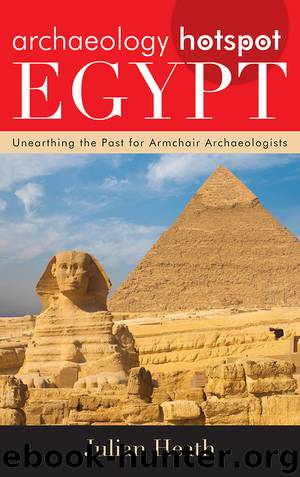Archaeology Hotspot Egypt by Julian Heath

Author:Julian Heath [Heath, Julian]
Language: eng
Format: epub
Publisher: Rowman & Littlefield Publishers
Published: 2015-12-08T16:00:00+00:00
4
Controversies and Scandals in Egyptology
On 6 January 1907, Theodore Davis’ excavator in the Valley of the Kings, Edward Ayrton, uncovered the entrance to a new tomb while he was working close to the tomb of Rameses IX. After breaking through the limestone walling that blocked the entrance, Ayrton found a simple tomb consisting of a flight of steps and a sloping corridor leading to a single, square burial chamber. It has been said that this tomb (KV55) “represents perhaps the most controversial archaeological discovery made in Egypt.”1
Ayrton found that KV55 was in something of a state, with building debris, various broken funerary items, and workers’ tools scattered across the floor of the burial chamber. Stacked against one of its walls were the components of a dismantled decorated wooden shrine gilded with gold leaf, fragments of which were everywhere inside the tomb. Hieroglyphic texts on the shrine recorded that Akhenaten had provided it for the burial of his mother, Queen Tiye, the wife of Amenhotep III. In a niche in the southern wall (probably an unfinished second chamber), there was a set of four alabaster Canopic jars with stoppers in the form of finely carved female heads wearing the distinctive Nubian-style bobbed wigs worn by Akhenaten’s daughters and wives. Egyptologists now believe that these jars were originally made for Akhenaten’s secondary wife, Kiya. Lying amidst the mess on the floor, on the southern side of the chamber there was also a decaying wooden rishi coffin2 that would originally have featured a beautiful sheet-gold face mask. Unfortunately, the thieves who had plundered the tomb in antiquity had brutally ripped this off, leaving just one eyebrow and an eye remaining. Lying in the coffin’s gold-plated interior was a mummy that had been badly damaged by water steadily dripping into the burial chamber over the centuries from a crack in its roof. Wrapped around the head of the mummy was a beautiful sheet-gold vulture that had originally been designed to be worn as a pectoral or collar. It is quite probable that the person who ripped off the outer face mask also stole the golden mummy mask that would originally have covered the face of the deceased, although why they left the collar behind is something of a mystery.
Given that the burial chamber contained her shrine, as well as Canopic jars made for female royalty, Theodore Davis came to the reasonable conclusion that the mummy must be that of Queen Tiye. Looking for further support to prove his theory, he asked a local physician, Dr. Pollock, and an American obstetrician who was overwintering in Luxor, to examine the mummy. Davis reported that both men confirmed that the body was that of a female. Interestingly, though, Arthur Weigall, who was chief inspector of antiquities at the time of the discovery of KV55, wrote, “I saw Dr Pollock in Luxor the other day, who denies that he ever thought that it was a woman, and he says the other doctor could not be so sure.
Download
This site does not store any files on its server. We only index and link to content provided by other sites. Please contact the content providers to delete copyright contents if any and email us, we'll remove relevant links or contents immediately.
| Africa | Americas |
| Arctic & Antarctica | Asia |
| Australia & Oceania | Europe |
| Middle East | Russia |
| United States | World |
| Ancient Civilizations | Military |
| Historical Study & Educational Resources |
The Daily Stoic by Holiday Ryan & Hanselman Stephen(2712)
The Fate of Rome: Climate, Disease, and the End of an Empire (The Princeton History of the Ancient World) by Kyle Harper(2441)
People of the Earth: An Introduction to World Prehistory by Dr. Brian Fagan & Nadia Durrani(2349)
Ancient Worlds by Michael Scott(2107)
Babylon's Ark by Lawrence Anthony(2073)
Foreign Devils on the Silk Road: The Search for the Lost Treasures of Central Asia by Peter Hopkirk(2058)
India's Ancient Past by R.S. Sharma(1988)
MOSES THE EGYPTIAN by Jan Assmann(1977)
The Complete Dead Sea Scrolls in English (7th Edition) (Penguin Classics) by Geza Vermes(1845)
Lost Technologies of Ancient Egypt by Christopher Dunn(1803)
The Daily Stoic by Ryan Holiday & Stephen Hanselman(1778)
The Earth Chronicles Handbook by Zecharia Sitchin(1753)
24 Hours in Ancient Rome by Philip Matyszak(1684)
Alexander the Great by Philip Freeman(1655)
Aztec by Gary Jennings(1548)
The Nine Waves of Creation by Carl Johan Calleman(1523)
Curse Tablets and Binding Spells from the Ancient World by Gager John G.;(1514)
Before Atlantis by Frank Joseph(1487)
Earthmare: The Lost Book of Wars by Cergat(1472)
